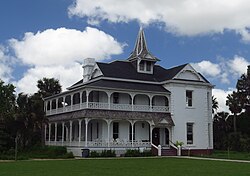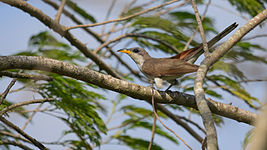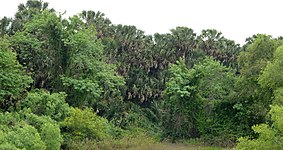
Fitzgerald Marine Reserve is a marine reserve in California on the Pacific Ocean, located just north of Pillar Point Harbor and Mavericks in the San Mateo County community of Moss Beach. Moss Beach is located approximately 20 miles (32 km) south of San Francisco and 50 miles (80 km) north of Santa Cruz. The reserve is a 32-acre (0.13 km2) holding which extends from Montara light station at the north to Pillar Point on the south. The reserve consists of a three-mile stretch of beach, tidepool habitat, marsh, erosive bluffs, clifftop trail and cypress and eucalyptus forests. The property is owned by the State of California and managed by San Mateo County as a county park and nature preserve. The reserve is administratively assigned to be part of the Monterey Bay National Marine Sanctuary. Adjacent to and possibly within the reserve is an endangered species of butterfly, the San Bruno elfin butterfly.
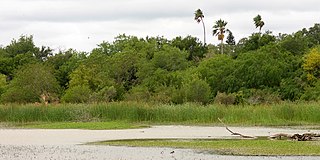
Resaca is the name given to a type of oxbow lake in the southern half of Cameron County, Texas. The resacas constitute former channels of the Rio Grande and are naturally cut off from the river, having no inlet or outlet.
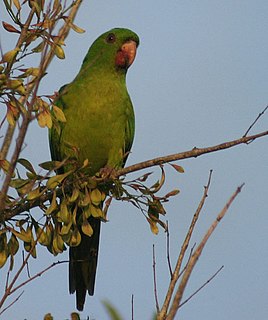
The green parakeet is a medium-sized parrot occurring in North and Central America, from the southernmost tip of Texas south to northern Nicaragua.
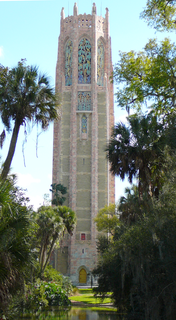
Bok Tower Gardens is a 250-acre (100 ha) contemplative garden and bird sanctuary located atop Iron Mountain, north of Lake Wales, Florida, United States. Formerly known as the Bok Mountain Lake Sanctuary and Singing Tower, the garden's attractions include the Singing Tower and its 60-bell carillon, the Bok Exedra, the Pinewood Estate, the Pine Ridge Trail, and the Visitor Center.

Big Talbot Island State Park is a state park in Florida, United States. It is located on Big Talbot Island, a coastal barrier island 20 miles east of downtown Jacksonville on A1A North and immediately north of Little Talbot Island State Park along the Atlantic coastal plain.

Valley Nature Center is a 6-acre park and nature preserve in Gibson City Park, Weslaco, Texas. Its focus is environmental education about the natural history of the Lower Rio Grande Valley.

Santa Ana National Wildlife Refuge is a 2,088-acre (8.45 km2) National Wildlife Refuge situated along the banks of the Rio Grande, south of Alamo in the Lower Rio Grande Valley, in Hidalgo County, South Texas.
The Baudó oropendola is a species of bird in the family Icteridae. It is endemic to Colombia. Its natural habitat is subtropical or tropical moist lowland forests, which are threatened by destruction. As it is only known from a small number of locations, its conservation status has been assessed as "endangered" by the IUCN.
The World Birding Center is the official title given to a combined nine parks and nature preserves in the Rio Grande Valley region of Texas managed by a partnership of the Texas Parks and Wildlife Department, the United States Fish and Wildlife Service, and the local communities in which the parks reside. The stated mission of the World Birding Center is to “protect native habitat while increasing the understanding and appreciation of the birds and wildlife,” with an additional emphasis on promoting local economic development through ecotourism.

The Tamaulipan mezquital is a deserts and xeric shrublands ecoregion in the southern United States and northeastern Mexico. It covers an area of 141,500 km2 (54,600 sq mi), encompassing a portion of the Gulf Coastal Plain in southern Texas, northern Tamaulipas, northeastern Coahuila, and part of Nuevo León.

Sabal mexicana is a species of palm tree that is native to far southern North America. Common names include Rio Grande palmetto, Mexican palmetto, Texas palmetto, Texas sabal palm, palmmetto cabbage and palma de mícharos. The specific epithet, "mexicana", is Latin for "of Mexico."

The Lower Rio Grande Valley National Wildlife Refuge is a 90,788-acre (367.41 km2) National Wildlife Refuge located in the Lower Rio Grande Valley region of southern Texas.

The Great Texas Coastal Birding Trail is a state-designated system of trails, bird sanctuaries, and nature preserves along the entire length of the Texas Gulf Coast in the United States. As the state of Texas hosts more bird species than any other state in the U.S. the trail system offers some of the most unusual opportunities for bird-watching in the world. The "trail" is actually 43 separate hiking and driving trails that include 308 birding sites. The sites themselves feature a variety of viewing opportunities with boardwalks, observation decks, and other amenities. The trails boast more than 450 bird species. The trail system is managed by the Texas Parks and Wildlife Department as part of the Great Texas Wildlife Trails which also include the Heart of Texas Wildlife Trail, the Panhandle Plains Wildlife Trail, and the Prairies and Pineywoods Wildlife Trail.

The Connecticut Audubon Society, founded in 1898 and headquartered in Fairfield, Connecticut, is a nonprofit organization dedicated to "conserving Connecticut’s environment through science-based education and advocacy focused on the state’s bird populations and habitats." Connecticut Audubon Society is independent of the National Audubon Society (NAS), just as in the neighboring state of Massachusetts, where Massachusetts Audubon Society is independent of the NAS.

Bentsen-Rio Grande Valley State Park is located at 2800 S. Bentsen Palm Drive south of the city of Mission in Hidalgo County in the U.S. state of Texas. It serves as the headquarters for the World Birding Center.
The Gorgas Science Foundation is a nonprofit foundation based in South Texas established to support conservation and education.
Resaca de la Palma State Park is one of three state parks belonging to the World Birding Center and managed by the Texas Parks and Wildlife Department. At 1,200 acres, Resaca de la Palma State Park is the largest of the World Birding Center sites and is located in Brownsville. The property was acquired by the Texas Parks and Wildlife Department in 1977 and was opened to the public in December 2008. A resaca is a type of oxbow lake that can be found in Texas, and is a former channels of the Rio Grande. It is naturally cut off from the river, having no inlet or outlet.

The National Butterfly Center is a private nature preserve which serves as an outdoor butterfly conservatory. It is located adjacent to Bentsen-Rio Grande Valley State Park, near the city of Mission in Hidalgo County in the U.S. state of Texas.
